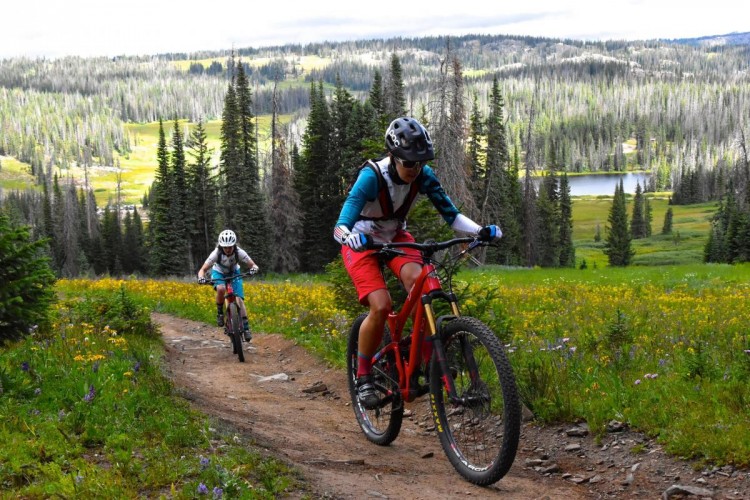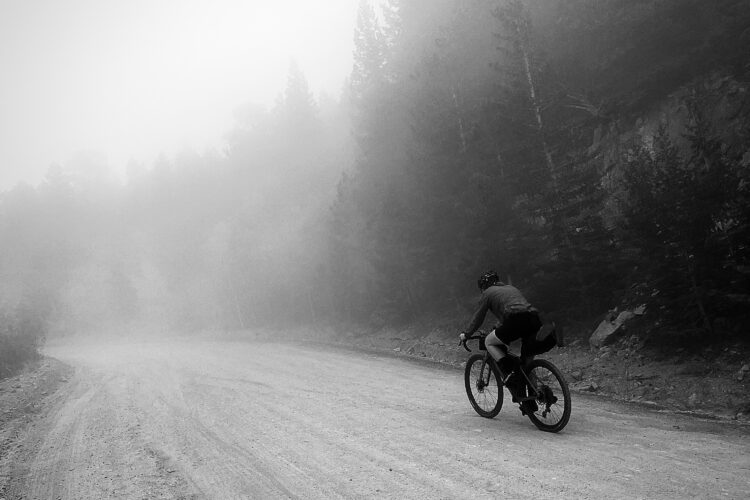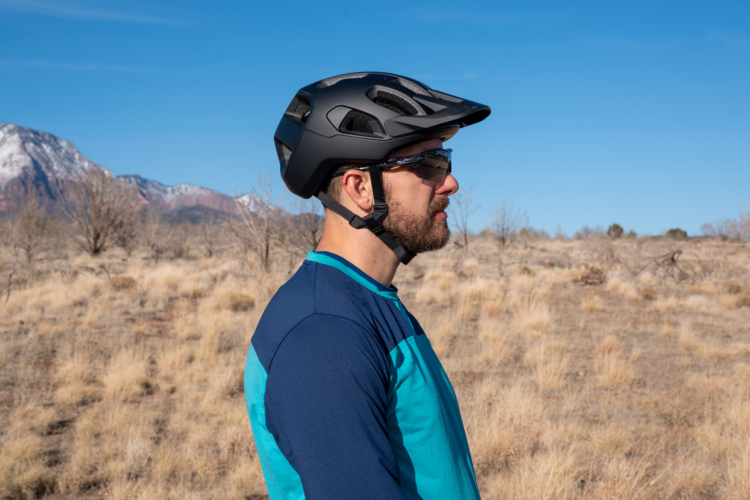If you’re a mountain biker with decent fitness, you’re probably capable of extending your mileage and doing an epic ride with eye-popping stats. It doesn’t require a special diet or a 12-week training plan, but it does requires you to think and ride differently.
For a long time I was satisfied with my usual 8- to 12-mile rides that lasted from an hour to an hour and a half, and a long ride for me was about 20 miles and two hours. But as my 50th birthday loomed, I decided to try a 50-mile ride. Previously, my longest ride ever was about 35 miles, and I wondered if I could crank out those extra 15 miles.
For a little background, I’m not a racer, and I don’t train. I ride. I also have no history as an endurance athlete, and I’m not a regimented person. But I’ve always been curious about my potential, and I strive to improve my riding, despite my sometimes-slacker nature. Skipping to the punchline, I cranked out 52 miles with 6,000 vertical feet of climbing in 5 hours and 20 minutes of riding time, with another hour or so of rest stops and food breaks in between.

Adding Miles
No shocker, the first thing I did in preparation was ride more, but nothing extreme. I tried to get out a few times a week and build a bit more endurance. Instead of loading the bike in the truck and driving to a trailhead, I rode pavement to it. This added mileage and saddle time, but they were manageable miles. The ride home got me used to riding while tired and cranking out extra miles without the psychological hurdles of grueling trail climbs or technical descents. All I had to do was stay in the bike lane and turn the pedals.
I also added trail miles to my usual rides, including extra climbs and out-of-the-saddle intervals. My goal was to stress my body a little more than usual, both in intensity and duration, but not kill myself. I didn’t wear a heart rate monitor, I just used common sense. If I got lightheaded during an interval, I backed off. Too sore the next day? Recover and try again later.
Rather than doing a 50-mile backcountry loop, I settled on multiple laps on my local trails that are linked by short sections of road between them. The goal was to stay on dirt as much as possible, and riding locally meant I was familiar with every section of trail I would ride and have no surprises with the terrain.
Gearing Down
I got a lot of help from my friend, Dan Kouba, who has trained for and competed in endurance races. He coached, encouraged, and rode with me.

The most valuable thing he taught me was to keep my heart rate low by gearing down and riding slower. I mentioned that I didn’t wear a heart rate monitor, and our rule of thumb was if I couldn’t speak in complete sentences without gasping for air, I was pushing too hard. That’s become my most valuable rule of thumb for longer rides, which makes sense. It’s like the difference in effort between walking and running.
Hills were more challenging, and our route included some steep and prolonged climbs. I stashed my ego in my backpack and dropped into the granny gear on stretches where I would usually ride in the big ring of my 2x drivetrain and stand on the pedals if needed. The first 15 miles were slower than normal, but physically, they felt like a warm-up ride around the block.
Black to Blue

Like most mountain bikers, I love riding downhill–the faster, the better. It’s common for me to be as winded after a hard-charging downhill as I am after a steep climb. But on this ride, I used downhills as a chance to catch my breath and rest my legs. I knew I would be physically and mentally tired during the long ride, and the difference between cleaning or crashing in a technical section is often a split-second decision and response. I wouldn’t be as sharp as usual, especially in the second half of the ride, so I rode at about 80 percent of my usual downhill speed. Where I usually attacked a downhill like a black diamond run, I cruised like it was a blue-level groomer.
Beyond the halfway point, I started to feel the miles, but knew I had more in me. Would I have enough? At the time I didn’t know, but I was confident that if I continued Dan’s riding strategy, I could do it.
It’s All Temporary
I also leaned on the experience of fellow Idahoan and pro mountain biker Rebecca Rusch, who was my unknowing muse on this ride. She’s known as the “Queen of Pain” for her super-human feats of endurance riding. In her book, Rusch to Glory, she imparted this gem of wisdom: “No matter how good or how bad you feel, it won’t last.”
The “bad” part was counterintuitive to me. I figured when you get tired, it’s a downward spiral from there… but not necessarily. You can ride through fatigue until your body finds the next well of energy.

That also coincided with Dan’s advice about food. He told me to fuel for what I was about to ride, not what I’d already ridden. A common mistake I make is to rest and eat at the top of a climb as a combination of replenishment and reward. He also advised me that at some point, I would need some “real food,” not my usual subsistence of GU packets and Clif Bars. A balanced mix of food kept my stomach happy and my mind looking forward to the next rest stop.
Gutting it Out
I won’t candy-coat it. There were moments toward the end when I was hot, tired, and thirsty regardless of how much I drank. It was my body saying, “are we there yet?” like a fussy school kid. The snap in my legs was long gone, and lactic acid turned my quads to mush.
This was the part I dreaded. My body and brain considered tapping out. It’s when you have to turn off the rational part of your brain and tap into its reptilian core. Am I tired? Yes. Would stopping feel better? Yes. Can I keep spinning the pedals? Yes. Then keep riding and tell the whining voice in your head to shut the hell up.
I also ignored the bike computer on my handlebars, which taunted me with its slow turn over of the miles. Dan had a GPS that was more accurate than my bargain-basement model. As we pedaled in sober silence, he broke it by announcing “that’s 50.” It woke me from my stupor because my computer showed I was still short of the mark. As much as I would like to say Dan’s declaration brought a surge of elation and joy, a sigh of relief is more accurate. I also knew I still had a couple miles of pavement to get home, so while I had met my goal, my ride wasn’t over.
Arriving home was anticlimactic. All I wanted to do was sit and stare, then take a hot shower to wash away the dust and sweat. But a cold beer and a comfortable chair brought it all into perspective: 52 miles and climbing 6,000 vertical feet seemed like someone else’s stats, but they were mine. I had earned them.

What I Learned
You don’t have to be an Olympian to ride long distances, but you can’t treat a long ride like your after work sessions or your weekend fun rides. It takes preparation and a willingness to endure some discomfort.
By pacing myself, consistently eating and drinking, and taking rest stops as needed, I could pedal through my “pain cave,” which was more of a dull pounding than a sharp stab. I also learned that I could bore through multiple walls of fatigue and mine layers of energy behind them.
Most importantly, I tested my physical limits and recalibrated my mental gauges. A 10-miler now feels like a spin around a pump track, and the psychological hurdle of a 20-miler is hopped like a curb. When the miles drag on and the end of the ride seems beyond the horizon, I know that all I have to do is gear down and keep pedaling.





















21 Comments
Jul 6, 2016
Jul 5, 2016
That said, I'd recommend at least some sort of training plan if you're going for 100 miles. I followed this one that Jeff wrote up, and it worked really well for me: http://www.singletracks.com/blog/mtb-training/the-dirty-century-training-plan-for-finishers/
Jul 5, 2016
Jul 5, 2016
Jul 5, 2016
Jul 8, 2016
We traversed a few valleys and worked our way over to a cliff that has spokes hammered into the rockface for hikers to climb. We took ropes and pulled the bikes up after us. from there we had a 20klm ride back to civilisation.
Problem was I had a badly leaking tyre (for Americans, that would be tire) that plagued me all the way, necessitating pumping it up every few klms. Stupidly we had no spares or even patching kits. Nor did we have much food, lights or warm clothes.
After the climb my tyre finally gave up the ghost forcing me to walk the last 15klms alone in the dark back to civilisation, our car and food on what turned into a very cold evening.
I learned a few lessons that night.
Jul 7, 2016
"Rather than doing a 50-mile backcountry loop, I settled on multiple laps on my local trails that are linked by short sections of road between them. The goal was to stay on dirt as much as possible, and riding locally meant I was familiar with every section of trail I would ride and have no surprises with the terrain."
Was this for training or the actual ride? I have a nice 22 mile loop that I could try, and, like you multiple ways to get back for that just in case scenario.
I have trained for an ran marathons, but for mountain biking I just like doing it, not training, so your plan sounds perfect.
Jul 7, 2016
Jul 8, 2016
Jul 7, 2016
Jul 8, 2016
Also, beer.
Jul 8, 2016
Jul 8, 2016
Jun 23, 2017
I'm 38 and ride a lot but consider 20 miles to be epic, I'm gonna see if I can double down and hit 40 after reading this.
Thanks for taking the time to share.
Jul 4, 2016
Jul 8, 2016
Last year was my third semi-full full year of riding, and I did a 41 mile ride, putting together some favorite trails in the Colorado Springs area. That was about double my longest ride on any given day up to that point. Though I was a mid-distance runner much of my life, early in my biking I found that the distance running really didn't help that much in riding except for the cardio and having some cardio for higher elevation. My progress in biking has had everything to do with slowly building upper leg strength and endurance and more importantly core strength and endurance (especially the hip area). Running does little for these and probably subtracts muscle and strength in these areas. I hope this year to put in a 60 mile ride -- instead of 50 just to jump past the 50 barrier. I also hope to do a 150 - 200 mile multi-day backpacking ride. Thanks for the inspiration Roger.
Jul 8, 2016
Jul 7, 2016
Jul 8, 2016
Jul 8, 2016
I don't think the author made any mention of doing any of this for fitness, health, or any other reason. It sounded like he did it for the challenge of it.
I always chuckle to myself when people think that I mountain bike to stay healthy. Being healthy is a nice side effect, but I--and I think most people--ride because it's FUN!
Jul 8, 2016